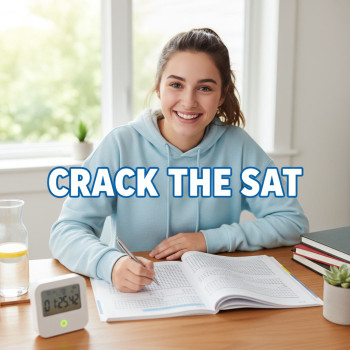Why this matters: A calm, clear conversation about SAT scores
As a parent, you want what every family wants: to help your student present their strongest possible application while avoiding unnecessary stress and cost. The SAT is one piece of a larger admissions puzzle—but it’s a piece that can feel confusing because of terms like “superscore” and “Score Choice.” In this guide I’ll walk you through what those terms mean, how colleges commonly treat SAT results, and practical actions families can take. We’ll also look at sample scenarios, a simple decision table, and tips for working with a tutor or a personalized program like Sparkl that can make the test prep journey less overwhelming and more effective.

Superscoring vs. Score Choice: what’s the difference?
These two terms are often used interchangeably in conversation, but they are different—and the distinction matters when you decide which SAT scores to send to colleges.
Score Choice — your power to choose
Score Choice is a College Board feature that allows students to decide which SAT test dates to send to colleges. If a student has taken the SAT multiple times, they can choose to send only the dates that show their best performance. This is done by test date, not by individual section scores. Think of Score Choice as a filter: you can withhold whole test dates that you believe don’t help your application.
Superscoring — how colleges assemble your best pieces
Superscoring is a college practice (not a College Board policy) where an admissions office takes the highest section scores from different test dates and combines them into a new, higher composite score. For example, if your student scored better on Reading & Writing on one date and better on Math on another, a college that superscores would consider those best section scores together.
Key difference summed up
- Score Choice = which test dates you send (College Board tool).
- Superscoring = how a college may combine scores from multiple dates for admission consideration.
Why colleges’ policies vary and why it matters to you
Every college sets its own policy about superscoring and which scores it requires. Some colleges publicly state that they superscore; others require all scores; others consider the highest single test date. That variation means the best approach depends on your college list—and why it’s essential to check each college’s admissions page when planning.
Practical takeaways for parents:
- Assume policies differ. Don’t assume one-size-fits-all.
- Check each college’s official admissions page before sending scores.
- When in doubt, sending the best dates (Score Choice) and confirming superscore policy with the college is wise.
Common scenarios and a straightforward strategy
Below are real-world situations you may recognize and a recommended approach for each.
Scenario 1 — Strong improvement across dates
Student A started with an SAT total of 1080, then after focused prep scored 1270. If colleges on the list accept superscores or you use Score Choice to only send the later date, the admissions team will see the 1270 (or a superscore that could be even higher if section strengths vary). Recommended action: send the higher date using Score Choice and confirm whether target colleges superscore—if they do, you may consider sending both dates so the superscore is visible.
Scenario 2 — Mixed strengths across dates
Student B scored 650 Math / 540 Reading on one date, then 600 Math / 620 Reading on another. Neither single date is perfect, but a college that superscores could combine the 650 Math and 620 Reading into a stronger profile. Recommended action: send both dates if the college superscores; if the college does not superscore, consider sending only the single best date via Score Choice.
Scenario 3 — Test-optional or test-blind colleges
Some colleges are test-optional—students can choose whether to submit scores—while others remain test-blind and do not consider scores at all. If your student’s application is strong in coursework, essays, and extracurriculars, withholding scores from test-optional colleges can be a reasonable path. Recommended action: pair the choice with candid feedback from a trusted counselor or tutor. If you’re working with a personalized tutor (for example, Sparkl’s 1-on-1 guidance), ask them to weigh in based on the student’s full profile.
How to build a sending plan that saves money and stress
Sending scores has costs if you exceed free sends, and timing matters: Score Choice is not available for the free score sends at test registration in some cases. Here’s a simple, parent-friendly plan:
- Before testing: create a college list and document each school’s score policy (superscore, require all scores, test-optional, etc.).
- During testing: pick a reasonable schedule—usually 1–3 SAT attempts spaced months apart, with focused prep between dates.
- After testing: evaluate scores with your student, a counselor, or a tutor. Use Score Choice to send only the most competitive dates where appropriate.
- If your student has strong section variability, consider sending multiple dates to colleges that superscore so they can assemble the best composite.
Table: Quick reference for deciding what to send
| Student Profile | College Policy (example) | Recommended Sending Action |
|---|---|---|
| Clear improvement (one much higher date) | Superscore or single best date accepted | Send the single best date with Score Choice; consider sending earlier dates only if needed for scholarships |
| Mixed section strengths across dates | College superscores | Send all relevant dates so college can superscore |
| Test-optional colleges | Test-optional | Evaluate application holistically; withhold scores if they don’t strengthen application |
| College requires all official scores | Requires all | Send every official score report |
How scholarships and majors complicate the picture
Remember that scholarship committees and specific programs (like engineering or business schools) may have their own score-use practices. Sometimes a department will prefer to see all dates, or scholarship applications may calculate eligibility from the highest single test date. That’s why it’s crucial to check both the admissions office and the program or scholarship criteria for “score-use” rules.
Practical checklist for parents before sending scores
- Make a spreadsheet of colleges and their score policies (superscore, require all scores, test-optional). Update it as you find new info.
- Ask your student to list their top 8–12 schools—prioritize by fit and policy.
- Discuss the costs of sending scores and factor them into your plan.
- Talk to a guidance counselor or tutor to get an independent read on whether scores will help (Sparkl’s personalized tutoring can provide tailored, data-driven guidance if you want 1-on-1 support).
- Decide on a final “score submission deadline”—often a few weeks before application deadlines—so there’s time to order reports.
How to interpret percentiles and superscores in the admissions context
Colleges often publish the middle 50% SAT range of admitted students. Superscoring can elevate your student’s effective position within that range because it may boost composite scores. But remember: admissions decisions are holistic. A higher superscore helps, but it’s one of several important factors including GPA, coursework rigor, essays, recommendations, and extracurricular activities.
Working with a tutor or test-prep partner: what to ask
If you’re considering extra help, asking the right questions helps you select a productive, cost-effective option. Whether you’re working with a local tutor, an online coach, or a tailored program like Sparkl, these topics will tell you whether the fit is right:
- Do they build personalized study plans based on diagnostic results?
- Will they track section-level progress and focus on weak areas?
- Do they provide realistic practice tests, with proctoring or timed conditions?
- Do they offer guidance on score-sending strategy (Score Choice) and how to plan test dates?
- Are tutors trained to help with motivation, time management, and college planning as well as content?
Programs that combine expert tutors with data-driven insights and individualized plans—like Sparkl’s 1-on-1 tutoring and AI-informed study paths—can be especially effective for families who want clear milestones and accountability without micromanaging every practice session.
Examples: Two student stories (realistic, anonymized)
Ella — the rising senior who improved steadily
Ella took the SAT once as a junior and got a reasonable score but felt nervous. Over the summer she worked with a tutor on targeted math concepts and timed reading practice. On her second test she improved significantly. Because the colleges on her list accept superscores, Ella asked the College Board to send both dates. Admissions departments combined her best section scores and her superscore positioned her comfortably within the middle 50% for several of her target schools. The family saved time and stress by planning two well-spaced test dates and focusing on practice that addressed specific weaknesses.
Marcus — a student with mixed section performance
Marcus scored very well in Math on an early date but struggled with Reading & Writing that day. On a later date he flipped the pattern: his Reading & Writing improved while Math dipped slightly. Because many of Marcus’s target programs superscored, his counselor recommended sending both dates so admissions offices could combine his best Math and best Reading & Writing. In one case, a scholarship committee required all scores; Marcus’s family confirmed that early so they ordered a complete score report early in the process.
Timing and logistics: when to order score reports
Order official score reports with enough lead time for application deadlines and for scholarship consideration. College application systems often require that official score reports be received by a specific date—double-check each school’s deadline, and factor in processing time. If there’s a rushed need, plan for the possibility of an expedited send (and the cost). A clear timeline eliminates last-minute scrambling and helps everyone breathe easier.
Common parent questions — answered plainly
Q: Should my child take the SAT multiple times?
A: Usually yes, but limited attempts with focused preparation are better than repeated, unfocused retakes. Most students benefit from 1–3 attempts spaced several weeks to months apart, with targeted study between tests.
Q: Does superscoring give an unfair advantage?
A: Superscoring seeks the highest demonstration of skill by combining best section scores. Colleges use it to get a fairer sense of ability when students have variable performance—it’s one of many holistic tools used in admission decisions.
Q: What if a school requires all scores?
A: If a college explicitly requires all official scores, you must send them. Failing to do so can disqualify an application. Always verify the policy on the college’s admissions page.
Final checklist and recommended next steps
- Create and maintain a college-policy spreadsheet (superscore, require all, test-optional).
- Plan 1–3 SAT dates with clear goals for each test (diagnostic, targeted improvement, final run).
- Use Score Choice wisely: decide whether to send selective dates or all dates depending on each college’s policy.
- Work with a counselor or an expert tutor to evaluate scores in the context of the whole application. If you want personalized plans, look for programs that offer 1-on-1 guidance, tailored study plans, and data-driven feedback—Sparkl offers these supports and can help families choose the right test plan and prep focus.
- Order official reports well before deadlines and confirm receipt when possible.

A reassuring note to parents
Admissions season is a marathon, not a sprint. Superscoring and Score Choice are tools you can use strategically, but they don’t replace thoughtful planning, consistent study, and a well-rounded application. Your guidance—practical, steady, and encouraging—matters more than any single test score.
If you’re unsure which path to take, invite a neutral observer—like a school counselor, an admissions coach, or a qualified tutor—to review the profile. Personalized tutoring programs that blend human expertise and technology can simplify decisions, reduce stress, and help your student build confidence with measurable progress.
Closing: How to turn information into action
Step 1: Make a short list of target colleges and record their score policies. Step 2: Create a testing timeline tailored to your student’s schedule and stress tolerance. Step 3: Use Score Choice thoughtfully and confirm superscore policies with colleges that matter most. Step 4: Get targeted help if needed—whether a few strategic sessions with an expert tutor or a structured, personalized plan that tracks progress.
With a bit of organization and the right support, you can turn SAT strategy from a source of worry into a manageable, even empowering part of the college application journey. You’ve got this—and your student does too.
Quick resources list (for your planning notebook)
- Spreadsheet: College name / superscore policy / score requirement / scholarship rules / application deadline.
- Testing timeline: planned test dates, goal scores, and check-in dates for progress.
- Contact list: counselor, test-prep tutor, and anyone else helping with applications.
Keep records simple, revisit them often, and treat each test as feedback and an opportunity to learn—not a final judgment. Your steady, practical support is the single most important ingredient in your student’s success.

















No Comments
Leave a comment Cancel